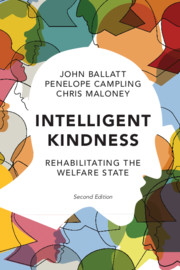Book contents
- Intelligent Kindness
- Reviews
- Intelligent Kindness
- Copyright page
- Contents
- Foreword
- Authors’ Note
- Chapter 1 The Heart of the Matter
- Chapter 2 Rescuing Kindness
- Chapter 3 A Politics of Kindness
- Chapter 4 Building the Case for Kindness
- Chapter 5 Managing Feelings of Love and Hate
- Chapter 6 The Emotional Life of Teams
- Chapter 7 Cooperation and Fragmentation
- Chapter 8 On the Edges of Kinship
- Chapter 9 Unsettling Times
- Chapter 10 Free to Serve the Public?
- Chapter 11 Blame
- Chapter 12 The Hostile Environment
- Chapter 13 The Pull towards Perversion
- Chapter 14 Cultivating Intelligent Kindness
- Chapter 15 Rehabilitating the Welfare State
- Index
- About the Authors
- Acknowledgements
- References
Chapter 4 - Building the Case for Kindness
Published online by Cambridge University Press: 28 February 2020
- Intelligent Kindness
- Reviews
- Intelligent Kindness
- Copyright page
- Contents
- Foreword
- Authors’ Note
- Chapter 1 The Heart of the Matter
- Chapter 2 Rescuing Kindness
- Chapter 3 A Politics of Kindness
- Chapter 4 Building the Case for Kindness
- Chapter 5 Managing Feelings of Love and Hate
- Chapter 6 The Emotional Life of Teams
- Chapter 7 Cooperation and Fragmentation
- Chapter 8 On the Edges of Kinship
- Chapter 9 Unsettling Times
- Chapter 10 Free to Serve the Public?
- Chapter 11 Blame
- Chapter 12 The Hostile Environment
- Chapter 13 The Pull towards Perversion
- Chapter 14 Cultivating Intelligent Kindness
- Chapter 15 Rehabilitating the Welfare State
- Index
- About the Authors
- Acknowledgements
- References
Summary
In the previous chapter, we argued the case for valuing kinship, positive connections and kindness as key determinants of the health and wellbeing of societies. The more people have in common, the more equal they are, the more links between them, and the more they invest in each other, the healthier the society, in physical, mental and social terms. We suggested that politicians and other leaders have a responsibility to articulate and champion emotional, social and financial investment in strengthening kinship, and to challenge individualistic preoccupations and ambivalence about the ‘common good’. We would argue that to take on this challenge is the political expression of intelligent kindness.
There is a similar case to be made for bringing such intelligent kindness into its proper place in the practice and organisation of health and social care. Here we must engage with a pervasive and problematic split.
- Type
- Chapter
- Information
- Intelligent KindnessRehabilitating the Welfare State, pp. 37 - 50Publisher: Cambridge University PressPrint publication year: 2020



